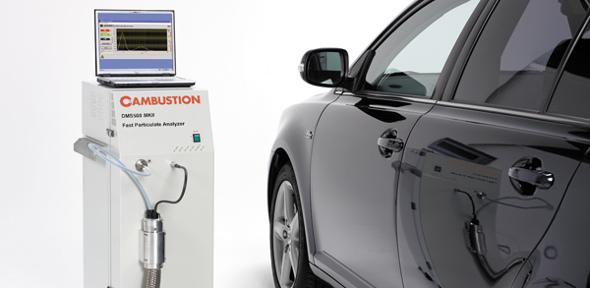
Staff at the Department of Engineering spin-off company Cambustion were joined by their families at September's Duxford Airshow, to celebrate 25 years at the forefront of global engine emissions research.
Vehicle emissions are a global problem, and Cambustion's products have been sold in 26 countries around the world, where they are used for both fundamental combustion research in universities and to improve the emissions performance of engines by vehicle manufacturers.
In the late 1980s the drive to improve air quality placed increasing scrutiny on vehicle emissions. A tea room conversation between the Department's Nick Collings and Rex Britter lead to the timely development of an analyser capable of measuring hydrocarbon emissions from a running engine on a cycle-by-cycle basis, where previous measurements has been on a timescale of several seconds. This allowed Nick and his team; Nigel Baker, Steve Dinsdale, Tim Hands, Steve Montgomery and John Willey to investigate the emissions performance of engines in unprecedented detail. Early collaboration and joint publications with the Ford Motor Company followed. Realising that the analyser had commercial prospects, the research group formed Cambustion to bring to market a fully developed system.
Seeking somewhere to set up the business, Cambustion became the first tenants of the St John's Innovation Centre, although a subsequent move closer to the Department saw the company occupy a house on Portugal Place in the very centre of Cambridge.
Running a manufacturing company from a terraced house with no vehicle access turned out not to be totally straightforward (although it did have its advantages), but a move to more conventional office space in the mid 1990s saw the company placed to expand. The rise of the Internet and email made it viable to support customers using Cambustion's unique products abroad- these days the fax machine is virtually redundant. Now one of the company's most effective marketing tools is an online list of the technical publications produced by researchers using Cambustion products and published in journals around the world.
Since then Cambustion has continued to develop new emissions analysers, including sensors for hydrocarbons, oxides of nitrogen, carbon monoxide/dioxide and particulates. Vehicle emissions legislation first introduced across Europe in 1992 limits the permissible levels of these emissions and subsequent legislation has seen permissible levels steadily reduce, bringing air quality benefits to all.
Having developed the tools, Cambustion were faced with the challenge of convincing others of the value of the data produced. The logical step was to undertake consulting work, initially renting engine dynamometer facilities at the Department of Engineering, and then building four high tech engine test cells at their headquarters on Cherry Hinton Road in Cambridge. The consultancy business turned out to be much more than a marketing tool and continues to expand, with plans already well underway to build further test cells during 2012.
The strong links with the University have also provided Cambustion with a steady pool of talent, a large proportion of the employees studied at the University.
Vehicle emissions are a global problem, and Cambustion's products have been sold in 26 countries around the world, where they are used for both fundamental combustion research in universities and to improve the emissions performance of engines by vehicle manufacturers. The link between industry and university customers has proved particularly valuable to Cambustion, since students exposed to Cambustion's products during their research often go on to do similar work in industry, bringing with them their knowledge and experience of what Cambustion can offer. Together with repeat sales into traditional markets such as the USA, Europe and Japan, recent years have seen an expansion into China with a local office, and many sales to Chinese universities.
In 2012 Cambustion's latest product for measuring ultrafine aerosol particle mass was launched. The main application of this product lies outside traditional automotive R&D and is already generating great interest in the atmospheric aerosol community with sales to China, Europe, Japan and the US. Cambustion's large and ever expanding R&D team continue to develop new products for gas and particle measurement.

